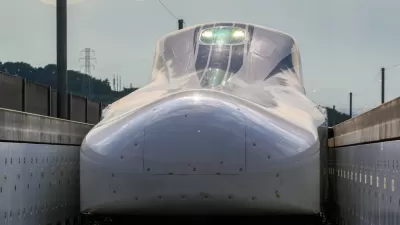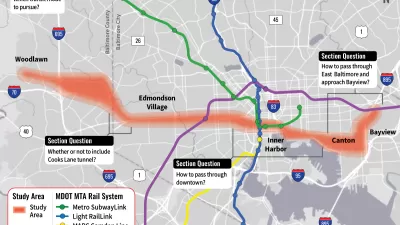The 105-year old Hudson River Rail Tunnels may desperately need replacement, but the Federal Railroad Administration also has an eye on the future, awarding $27.8 million to prepare a maglev application between Washington and Baltimore.
Following-up on a post a year ago, "(a)n investor group hoping to build a high-speed train capable of cutting the travel time between Baltimore and Washington to 15 minutes" got some great news from the U.S. Department of Transportation (DOT) on Friday.
According to the Nov. 6 DOT press release, a $27.8 million grant was awarded "to the State of Maryland for preconstruction and planning costs for the potential development of a magnetic levitation (maglev) train between Washington, DC and Baltimore, Md."
"Maryland’s Department of Transportation and the state’s Economic Development Corporation applied for the federal funds in April, with an understanding that the Japanese government and Baltimore-Washington Rapid Rail, a private group, would provide significant investments for the project," writes Josh Hicks, who covers Maryland politics and government for The Washington Post.
"The train could whisk passengers around at over 500 kilometers per hour (300 mph), and the first leg of the project could connect Washington to Baltimore in 15 minutes at a cost of about $10 billion," writes Aditya Kondalamahanty for the International Business Times.
"The project is being led by a private organization called The Northeast Maglev, which is working with railway officials in Japan," writes Eric Pfanner, senior corporate correspondent for The Wall Street Journal.
The public Japan Bank for International Cooperation "has promised $5 billion in financing but the private Central Japan Railway Co. 'has agreed to waive any licensing fees for use of its maglev technology'," notes last year's post.
The railway company, a longtime successful and profitable operator of the Shinkansen bullet train lines, is also backing the Dallas to Houston high-speed rail project.
Competition for Amtrak's Northeast Train Routes, including Acela?
"The money will support private-sector efforts to bring magnetic-levitation trains to the region as part of a larger vision for building a maglev system along the Northeast Corridor," adds Hicks.
Maryland requested $1.7 billion in federal funding for the maglev project in 2010, but the Federal Railroad Administration rejected the bid, declaring it “not ready.”
Maryland's first-term governor, Larry Horgan, is very supportive of the proposal.
“The ability to travel between Baltimore and Washington, D.C., in only 15 minutes will be absolutely transformative, not just for these two cities, but for our entire state,” Gov. Larry Hogan (R) said in a statement.
In fact, the $27.8 million request came after "Gov. Horgan rode the 27-mile Yamanashi maglev line outside of Tokyo during a 12-day trade trip...," wrote Rick SeltzerIf of the Baltimore Business Journal in June.
Federal maglev funding originated in 2005 when "Congress authorized $90 million for maglev transportation projects that would be capable of safely transporting passengers faster than 240 miles per hour," notes the press release.
In 2010, $45 million earmarked for Los Angeles to Las Vegas maglev was redirected to airport roads around McCarran International Airport in Las Vegas. The corridor is proceeding as a high-speed rail project called DesertXpress backed by the China Railway International Group and China Development Bank.
FULL STORY: Feds award $28 million to study ‘maglev’ train system for Maryland

Alabama: Trump Terminates Settlements for Black Communities Harmed By Raw Sewage
Trump deemed the landmark civil rights agreement “illegal DEI and environmental justice policy.”

Study: Maui’s Plan to Convert Vacation Rentals to Long-Term Housing Could Cause Nearly $1 Billion Economic Loss
The plan would reduce visitor accommodation by 25% resulting in 1,900 jobs lost.

Planetizen Federal Action Tracker
A weekly monitor of how Trump’s orders and actions are impacting planners and planning in America.

Waymo Gets Permission to Map SF’s Market Street
If allowed to operate on the traffic-restricted street, Waymo’s autonomous taxis would have a leg up over ride-hailing competitors — and counter the city’s efforts to grow bike and pedestrian on the thoroughfare.

Parklet Symposium Highlights the Success of Shared Spaces
Parklets got a boost during the Covid-19 pandemic, when the concept was translated to outdoor dining programs that offered restaurants a lifeline during the shutdown.

Federal Homelessness Agency Places Entire Staff on Leave
The U.S. Interagency Council on Homelessness is the only federal agency dedicated to preventing and ending homelessness.
Urban Design for Planners 1: Software Tools
This six-course series explores essential urban design concepts using open source software and equips planners with the tools they need to participate fully in the urban design process.
Planning for Universal Design
Learn the tools for implementing Universal Design in planning regulations.
Caltrans
Smith Gee Studio
Institute for Housing and Urban Development Studies (IHS)
City of Grandview
Harvard GSD Executive Education
Toledo-Lucas County Plan Commissions
Salt Lake City
NYU Wagner Graduate School of Public Service





























